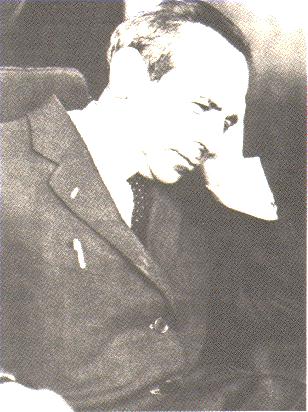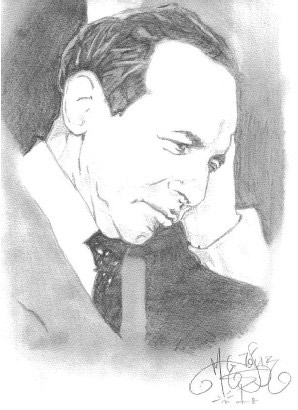<Back to Index>
- Economist Michał Kalecki, 1899
- Writer Henry Rider Haggard, 1856
- Prime Minister of the Netherlands Hendrikus "Hendrik" Colijn, 1869
PAGE SPONSOR


Michał Kalecki (June 22, 1899 in Łódź – April 18, 1970 in Warsaw) was a Polish Marxist economist who specialized in macroeconomics of a broadly defined Keynesian sort. Over the course of his life, Kalecki worked at the London School of Economics, University of Cambridge, University of Oxford and Warsaw School of Economics as well as an economic advisor to governments of Cuba, Israel, Mexico and India.
Kalecki has been called “one of the most distinguished economists of the 20th century” and has sometimes been regarded as a "left - wing" John Maynard Keynes. It is often claimed that he developed many of the same ideas as Keynes, before Keynes; however, since he published in Polish, he remains much less known to the English speaking world. He was also one of the first macroeconomists to apply mathematical models and statistical data to economic questions. Michal Kalecki was born in Łódź (Poland) on June 22, 1899. Information about his early years of life is very sparse, part of it being lost during the Nazi occupation. In 1917 Kalecki finished a Bachelor's degree, in order to join later the University of Warsaw, where he began civil engineering. He was a very clever student, and in this period he formalized a generalization of Pascal's theorem, concerning a hexagon drawn within a second degree curve. Kalecki generalized this for a polygon of 2n sides. However, after his father had lost a small textile workshop, and though he obtained a job as an accountant, the young Kalecki had to search for another job in order to earn some money. During his first year in Warsaw he
continued working sporadic jobs. After finishing his first year of
engineering, he had to abandon his studies and from 1918 to 1921 he was
in military service. Upon leaving the military he joined the Polytechnic of Gdansk, staying there until 1924. Kalecki was then 25 years old. During these years he first approached economics, although informally. He read mostly "unorthodox" works, particularly those of Mikhail Tugan - Baranovsky and Rosa Luxemburg.
Years later, this early influence of these two economists would be felt
in some of his own writings related to the potential growth of a capitalist system. In 1924 Kalecki was
about to finish his studies when his father lost his job again. This
forced him to leave the university again and this time permanently,
because he needed to find a better paid job. His first job (which was
also economic in nature) was to collect data on companies which asked
for credit. In this same period he tried unsuccessfully to start a
newspaper and then was forced to write articles for two economic
newspapers, the Polska gospodarcza and Przeglad gospodarczy. It was probably in writing these articles that he began to acquired skills in obtaining and analyzing empirical information which was later included in his writings. After
five years and many articles he applied in 1929 for work at the
Research Institute of Business Cycle and Prices (RIBCP). The experience
he had acquired in the use of statistics got him the job. On June 18,
1930, he married Ada Szternfeld. In RIBCP he met Ludwig Landau, whose
knowledge of statistics influenced
the way that years later Kalecki presented the statistical part of his
works. As a result his first works had a practical character
particularly in establishing relationships between macro - magnitudes.
In
fact the first article that anticipated many subsequent contributions
was published in 1932 in a magazine (which disappeared the same year)
called Przeglad socjalistyczny (Socialist Review), under the pseudonym of Henryk Braun. The article dealt with the subject of the impact of wage cuts during an economic downturn. It was the first step towards the contributions he would make the following year. In 1933 Kalecki wrote
an essay that brought together many of the issues which would dominate
his thoughts for the rest of his life. This essay was Proba teorii koniunktury (An
Essay on the Theory of the Business Cycle), which was published by the
RIBCP and in which for the first time Kalecki was able to develop a
comprehensive theory of business cycles. In October of the same year Kalecki read his essay to the International Econometrics Association and in 1935 published it in two major journals: Revue d’Economie Politique and Econometrica.
Although the readers of both journals were not particularly impressed,
Kalecki's article received favourable comments from such leading
economists as Ragnar Frisch and Jan Tinbergen. The following year he was granted a scholarship, which enabled him to travel to Sweden with his wife, where the followers of Knut Wicksell were trying to formalize a theory similar to Kalecki's. About that time he learnt of the publication of Keynes's General Theory. This was most likely his motive for traveling to England. He first visited the London School of Economics and afterward went to Cambridge. Thus began his friendship with Richard Kahn, Joan Robinson and Piero Sraffa, leaving an indelible mark on all of them. In 1937 he met John Maynard Keynes.
The meeting was cooler than expected, Keynes keeping aloof. Although
the conclusions they had arrived at in their respective works were very
similar, their characters could not have been more different. Kalecki very graciously neglected to mention that he enjoyed priority of publication. As Joan Robinson reminds us: In 1939 Kalecki wrote one of his most important works, Essays in the Theory of Economic Fluctuations.
Although his conception changed through the years, all the essential
elements of Kaleckian economics were already present in this work: in a
sense his subsequent work would consist of mere elaborations on ideas
he had already propounded. In 1937 his friend Ludwig Landau was ejected from the RIBCP for political motives, which moved Kalecki to
resign in protest and extend his stay abroad. But for this fortuitous
fact, the war would have caught Kalecki in Poland and given his Jewish origins he would probably not have survived. In
any case, the Oxford Institute of Statistics (OIS) hired Kalecki in
1940. His job there consisted mainly of writing reports for the British Government concerning the management of the war economy. This did not prevent him from giving the occasional lecture at Oxford University.
However, despite the elaborate reports prepared by Kalecki for the
Government (most of them were concerned with the operation of the
rationing of goods) the economists working for the Government often
disregarded these reports. They did so, among other reasons, because
many economists at the OIS were refugees. In the words of G. Feiwel:
“As a consequence of this void in historical reporting, Kalecki's work
of the war period is far less known than it deserves to be”. However,
some of Kalecki’s major works were written during this period: in 1943
he wrote two articles, one of which dealt with new additions made to
traditional business cycle theory.
The second article presented Kalecki’s completely original theory of
business cycles caused by political events. The latter was published in
1944 and was based on the premise of full employment.
Actually that article was a compilation of studies by Kalecki and his
colleagues at the OIS, who, however, were strongly influenced by
Kalecki’s thinking. In
1945 Kalecki left the OIS, upset because he felt that his talents were
not sufficiently appreciated. Kalecki displayed great modesty about his
work and did not expect to be paid splendid tribute for his
accomplishments. He was offended at being discriminated against on
account of his immigrant status. In fact, one reason why he left the
OIS and was not appointed to a more senior position was that he had not
applied to become a British subject. (“Subject” was the term then used
in Britain instead of “citizen”.)
Leaving OIS, Kalecki went to París, where he stayed not long, moving to Montreal later,
where he stayed fifteen months. In July 1946 he accepted the Polish
government invitation to head the Central Planning Office of the
Ministry of Economics, but he left some months later. At the end of
1946 he decided to move to New York. He liked the position offered him in the Economic Department of the United Nations Secretariat.
He remained there until 1954, allowing him to develop his work as a
political advisor. As in 1945, Kalecki resigned the position as a
protest signal. It was argued instead that he was punished on political
grounds (a non merited economic planner stance was attributed to him).
In any case, the Senator Joseph McCarthy’s witch hunt depressed him as many of his closest friends were directly affected. In 1955 he returned to Poland and basically never went back to work abroad for any extended period. When
he arrived in Poland, Kalecki was quite hopeful with the ability to
make reforms that were socially advantageous. In 1957 he was appointed
chairman of the Committee for the Perspective Plan. The plan had a
horizon covering 1961 to 1975, and was basically a practical level
embodiment of Kalecki's theories of growth in socialist economies.
However, the final plan developed by Kalecki was dismissed by board members
as too gloomy and tinged as defeatist. Then things got worse, as
related by G. Feiwel: Thereafter,
Kalecki spent much time of the rest of his life in teaching and
research. There were however issues that he had neglected during his
time at the Commission. In 1959 he began directing a seminar on the
socio - economic problems of the Third World along with Oskar Lange and Czeslaw Bobrowski.
For him the problem was not new, having already written outstanding
articles dealing with these issues thoroughly, especially those related
to development. He also devoted this period to the study of mathematics.
In fact, this was in part a continuation of the interest he had when he
was young and generalized Pascal’s theorem. The investigations were in number theory and probability.
For him these periods of time dedicated to mathematics were a release
of extreme disappointment caused by the lack of power to help his
country in economic policy. John Maynard Keynes had said years before that knowledge of the laws governing the capitalist economy would make people more prosperous, happy and more responsible with respect to the economic decisions taken. However, Kalecki contested this view, arguing that in fact the idea of political business cycle (governments
can force situations to their advantage) seems to point in the
opposite direction. As he grew older, Kalecki was ever more convinced
of this, showing an increasingly pessimistic view of humanity. Michal
Kalecki died on April 4, 1970 at the age of 70 years, and although he
was bitterly disappointed with all political developments, he lived
long enough to see recognized the value of his many original
contributions to economics. In his last visit to Cambridge he
gave a conference where he was greatly applauded for the clearness of
his explanation as well as by the trajectory of his life. Probably one
of the most moving paragraphs concerning the end of his life we owe
to Feiwel: